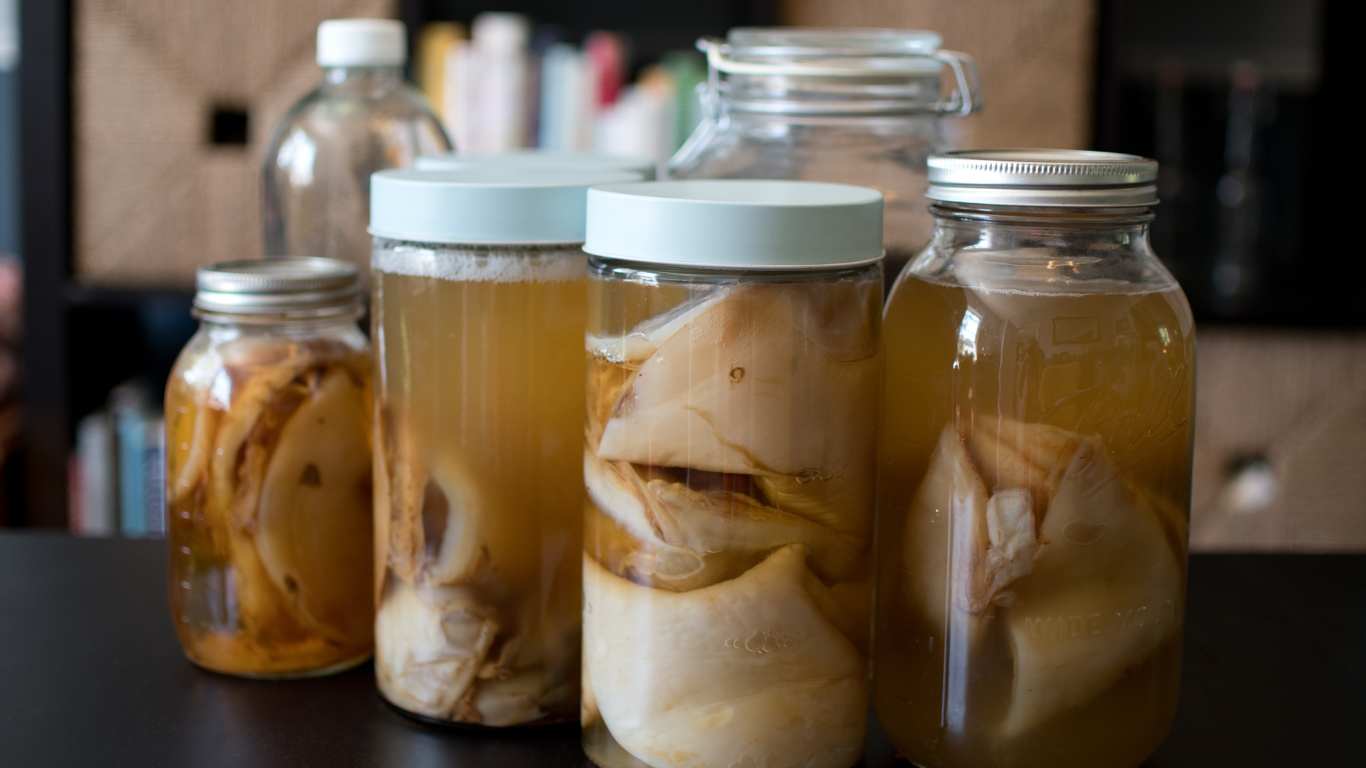SCOBY is a vital ingredient in the world of fermentation, particularly in crafting the beloved probiotic-rich beverage, kombucha. With its unique blend of microorganisms, SCOBY can transform your sweet tea into a tangy and enjoyable drink. However, for home cooks and curious fermenters alike, a rising question is, how long does SCOBY last?
SCOBY is a crucial component in the fermentation of kombucha. When stored properly in the refrigerator, a SCOBY can last for several weeks to a few months, depending on various factors.
Understanding the longevity of SCOBY is crucial for home fermenters, especially for maintaining a long line of kombucha. At the same time, the proper knowledge about how long SCOBY usually lasts can also ensure the best health codes for you. So, in this article, we will explore the factors influencing the lifespan of SCOBY and understand how long it can last.
How Long Does SCOBY Last In The Fridge?
A well-maintained SCOBY can last for several weeks to a few months in the refrigerator. However, it’s essential to periodically check its condition. Signs of a healthy SCOBY include its characteristic rubbery texture, a uniform cream or beige colour, and a slightly sour aroma.
If the SCOBY develops unusual colours, such as green or black spots, or emits foul odours, it may indicate contamination or spoilage, and it should be discarded. To help you understand better about SCOBY, here are some facts that impact how long your SCOBY will last in the fridge.

Temperature
The temperature of the refrigerator is typically set between 35°F to 40°F (1.6°C to 4.4°C). At these temperatures, microbial activity, including the fermentation processes carried out by the bacteria and yeast in the SCOBY, significantly slows down.
Lower temperatures slow down metabolic processes, including the consumption of nutrients and by-product production. This slowdown helps preserve the SCOBY and extends its shelf life. However, extremely low temperatures can also affect the viability of the microbial cultures within the SCOBY.
Freezing temperatures can damage the cell structures of the microorganisms. This will cause the SCOBY to show reduced fermentation activity and potentially spoil the SCOBY altogether. 0
Moisture
Maintaining adequate moisture is essential for the survival of the SCOBY during storage. SCOBYs are primarily composed of a matrix of cellulose, which is permeable to water. Without sufficient moisture, the SCOBY can dry out and become inactive or even die.
Storing the SCOBY in a liquid medium, such as finished kombucha or a mixture of brewed tea and sugar, helps retain moisture and prevents dehydration. When storing SCOBY in the fridge, maintaining adequate moisture is crucial to prevent dehydration and maintain its viability. Ensure the SCOBY is submerged in a liquid medium, such as finished kombucha or brewed tea, before refrigerating.
The cool environment of the fridge helps slow down evaporation, preserving the moisture content of the liquid medium and keeping the SCOBY hydrated. So, check the container periodically to ensure the liquid level remains sufficient to keep the SCOBY submerged. If needed, top up the liquid with additional brewed tea or finished kombucha to replenish moisture levels.
Air Exposure
Exposure to air can lead to oxidation and microbial contamination, both of which can adversely affect the SCOBY’s viability and quality. Storing the SCOBY in an airtight container minimizes exposure to oxygen, reducing the risk of oxidation and preventing the entry of airborne contaminants.
Minimizing air exposure is essential for preserving SCOBY in the fridge to prevent oxidation and contamination. During refrigeration, transfer the SCOBY and its liquid medium to an airtight container, such as a sealed glass jar or a food-grade plastic container. Airtight containers create a barrier against air and airborne contaminants, helping maintain the freshness and integrity of the SCOBY.
Cleanliness
Maintaining cleanliness is crucial when handling SCOBYs to prevent contamination by harmful bacteria or moulds. So, how long the SCOBY will last in the fridge also depends on how clean the storage container and the fridge’s hygiene are.
That is why, ensure that the container used to store the SCOBY is clean and sanitized before transferring it to the fridge. Regularly clean the fridge interior, especially the area where the SCOBY container is placed, to minimize the risk of cross-contamination from other food items. Additionally, sanitize any equipment used for handling SCOBYs to minimize the risk of introducing harmful microorganisms.
Age of the SCOBY
The age of the SCOBY can influence its viability and effectiveness during storage in the fridge. A young and healthy SCOBY is more likely to survive longer in refrigeration compared to an older or compromised SCOBY.
Before refrigerating the SCOBY, assess its health and vitality. If the SCOBY shows signs of decline, such as unusual colours, foul odours, or irregular textures, it may not be suitable for prolonged storage in the fridge. Consider refreshing the SCOBY by discarding older layers and retaining newer, healthier ones before refrigerating to optimize its lifespan and fermentation capabilities.

When Should You Throw Out A SCOBY?
You should throw out a SCOBY in some special cases. This includes not observing the thickness of SCOBY formation after the initial brewing and spotting unusual signs or marks on the SCOBY. If you find a bad smell that seems spoilt, you should throw out the SCOBY.
Knowing when to throw out a SCOBY is crucial for maintaining the quality of your kombucha. Wait until the SCOBY reaches a thickness of approximately ¼ inch before using it to brew your first batch of kombucha. This usually takes about 30 days, allowing the SCOBY to mature and develop a healthy culture.
If you don’t observe the formation of a SCOBY after three weeks of brewing, it’s recommended to discard the batch and start over. The absence of a developing SCOBY within this timeframe may indicate issues with the fermentation process or the health of the culture.
Green, slimy, or soft spots on the SCOBY’s surface can be signs of deterioration, particularly if it gets wet or sustains injuries. In such cases, it’s advisable to discard the SCOBY. Mould, visible as black fuzzy spots, is a clear indication that the SCOBY has gone bad. If mould growth is observed, it’s essential to discard both the SCOBY and the entire batch of kombucha to avoid health risks.
Foul odours, especially if accompanied by mould growth or other signs of spoilage, are reasons to throw out the SCOBY. A healthy SCOBY should have a slightly sour aroma indicative of the fermentation process.

How Many Times Can I Reuse A SCOBY?
Each SCOBY can be reused up to four times before it becomes too old and needs to be discarded. During each fermentation cycle, the mother SCOBY will produce a baby SCOBY, initiating the process anew. Therefore, if you reuse a SCOBY four times, you will have produced four baby SCOBYs in addition to the original mother SCOBY.
As a result, with each batch of kombucha, a new SCOBY is generated, contributing to a growing collection of SCOBYs over time. The effectiveness of the SCOBY in fermenting kombucha may change over time. Larger SCOBYs tend to work faster than smaller ones, potentially reducing the fermentation time required for subsequent batches.
For instance, if batch 1 was ready after 14 days of fermenting, batch 2 might become too bitter by then but may be perfect after only 10 days due to the growth of the SCOBY. This suggests that the SCOBY’s growth enables it to transform the starter mixture more rapidly, leading to faster fermentation times in subsequent batches.
So, while each SCOBY can be reused up to four times, the growth and transformation of the SCOBYs contribute to variations in fermentation times across batches. As a living organism, the SCOBY constantly adapts and grows, influencing the fermentation process and the quality of the kombucha produced.
If you would like to learn how to grow SCOBY without kombucha check out my complete guide on this topic.
Conclusion
For a home-grower or a curious fermenter, knowing how long your SCOBY lasts is a crucial understanding. From the expert fermenters to the amateur ones, the right understanding of SCOBY’s longevity will help in making the best brews. Thus, you can turn your favourite fermenting recipes come to life by using the best quality SCOBY.



